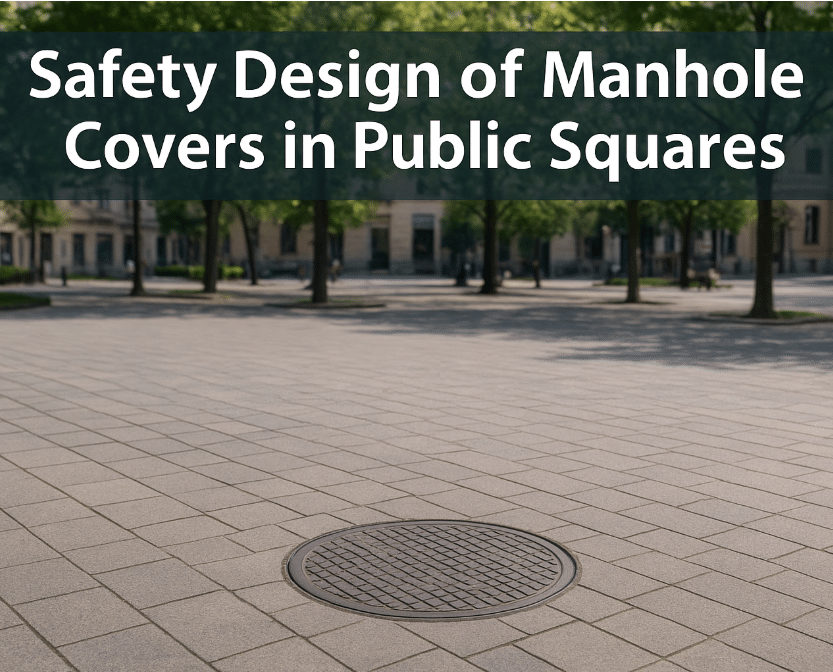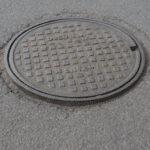Public squares are vital spaces in modern cities — where people gather, walk, and interact. Beneath these open areas lies a complex network of drainage, sewage, and communication systems, which require secure and reliable access points. The safety design of manhole covers plays a crucial role in ensuring public safety, preventing accidents, and maintaining long-term infrastructure performance.
This article explores how the manhole cover design is adapted for public squares, the key safety considerations during manhole cover manufacturing, and how proper installation and materials can protect both pedestrians and vehicles.
1. The Importance of Manhole Cover Safety in Urban Environments
Manhole covers serve as protective barriers between underground utilities and the surface environment. In public squares, they are often located in pedestrian zones, near fountains, or alongside light traffic areas. Therefore, their safety design directly affects daily life and urban safety.
1.1 Preventing Accidents and Injuries
A poorly designed or unstable manhole cover can lead to accidents — from tripping hazards to wheel jams. For this reason, safety standards for manhole covers are established to ensure load-bearing capacity, non-slip surfaces, and proper locking mechanisms.
1.2 Supporting City Aesthetics
In public squares, manhole covers are not just functional; they are part of the urban landscape design. Many cities now use customized designs that combine safety engineering with artistic patterns, reflecting cultural or architectural themes.
2. Core Elements in Manhole Cover Safety Design
Ensuring safety requires a comprehensive approach combining engineering precision, durable materials, and standard compliance.
2.1 Load-Bearing Standards
Different locations require different load classes. In public squares, the covers must withstand heavy foot traffic, maintenance vehicles, and in some cases, light-duty trucks. Common standards like EN124 and AASHTO M306 define classes from A15 to F900, ensuring that each manhole cover meets specific pressure limits.
2.2 Anti-Slip Surface Treatment
To prevent pedestrian accidents, non-slip surfaces are a must. During manhole cover manufacturing, designers integrate patterned surfaces such as grid textures or raised ribs to provide traction, even under rainy or icy conditions.
2.3 Locking and Anti-Theft Systems
Modern manhole cover designs include locking mechanisms that prevent unauthorized access and theft. Composite and ductile iron materials can be fitted with bolt locks or spring hinges, improving both security and usability.
3. Material Innovations in Safe Manhole Cover Manufacturing
Material choice is central to safety. The three dominant materials — cast iron, composite, and stainless steel — each have unique safety advantages.
3.1 Ductile Cast Iron: Strength and Durability
Ductile cast iron manhole covers are widely used due to their exceptional tensile strength and resistance to impact. Their weight provides natural stability, reducing the risk of displacement under load.
3.2 Composite Materials: Lightweight and Non-Conductive
Composite manhole covers are emerging as a safer and more eco-friendly alternative. They are corrosion-resistant, lightweight, and non-conductive — ideal for squares with electrical utilities below the surface. Their high customization options also support city branding and safety marking integration.
3.3 Stainless Steel Frames: Precision and Clean Aesthetic
Stainless steel frames combined with composite or ductile covers create a strong yet modern look. These hybrid systems offer long service life, excellent resistance to weathering, and precision fitting that prevents cover movement.
4. Installation Practices for Maximum Safety
Even a perfectly designed cover can pose a risk if not installed correctly. Proper installation of manhole covers in public squares ensures alignment, load distribution, and long-term reliability.
4.1 Base Preparation and Frame Positioning
Before installation, the base foundation must be level and structurally sound. The frame should align flush with the surface to avoid tripping hazards or water accumulation around the edge.
4.2 Sealing and Drainage Considerations
Water accumulation is a common issue in squares. Drainage slots or rubber seals are integrated into the cover design to prevent flooding and minimize corrosion.
4.3 Periodic Maintenance
Routine inspection helps detect loose fittings, rust, or surface wear. Establishing a preventive maintenance schedule every 6–12 months ensures the covers remain safe and compliant with standards.
5. Compliance with International Standards
Following recognized standards ensures the manhole cover safety design meets technical and performance benchmarks.
- EN124 Standard (Europe): Defines load classes and testing procedures.
- AASHTO M306 (U.S.): Focuses on load-bearing capacity and durability.
- ISO 1083: Specifies material properties for ductile iron covers.
Manufacturers like Xinghua Castings adhere strictly to these standards, offering manhole cover customization that fits local regulations and design requirements.
6. Engineering Adaptation for Modern Urban Spaces
Public squares often have special conditions such as artistic pavements, curved surfaces, or mixed-use zones. This requires customized manhole cover solutions that balance safety and visual harmony.
- Color-matched composites to blend with paving stones.
- Decorative laser engraving with anti-slip properties.
- Flush-fitting systems to eliminate height gaps.
Modern cities increasingly favor customized safety designs to integrate functionality with architectural aesthetics.
7. Environmental and Long-Term Safety Factors
The safety design of manhole covers also includes environmental considerations:
- Corrosion prevention coatings extend lifespan.
- Recyclable materials reduce ecological impact.
- Noise-dampening seals enhance urban comfort.
By optimizing both material selection and maintenance, city managers ensure safe and sustainable infrastructure for decades.
Conclusion
The safety design of manhole covers in public squares goes far beyond basic functionality. It encompasses structural strength, ergonomic surface design, secure installation, and aesthetic integration — all contributing to public well-being. As cities evolve, manhole covers will continue to adapt, ensuring that every step citizens take in public spaces is both safe and stable.
For long-term urban safety, cooperation between manufacturers, designers, and engineers is essential — ensuring that every manhole cover meets the highest safety and quality standards.
FAQs About Manhole Cover Safety Design
Q1: What standards should manhole covers in public squares meet?
They should comply with EN124 or AASHTO M306 standards, ensuring proper load capacity and safety features.
Q2: How often should manhole covers be inspected?
Every 6–12 months, depending on foot traffic and environmental exposure.
Q3: Are composite manhole covers safe for public squares?
Yes, they are lightweight, non-slip, corrosion-resistant, and provide excellent long-term safety with aesthetic flexibility.
Q4: What causes manhole cover displacement?
Improper installation, base settlement, or inadequate frame anchoring can lead to misalignment or noise.
Q5: Can manhole covers be customized for public projects?
Absolutely. Manufacturers like Xinghua Castings provide manhole cover customization to meet safety, design, and branding needs.





